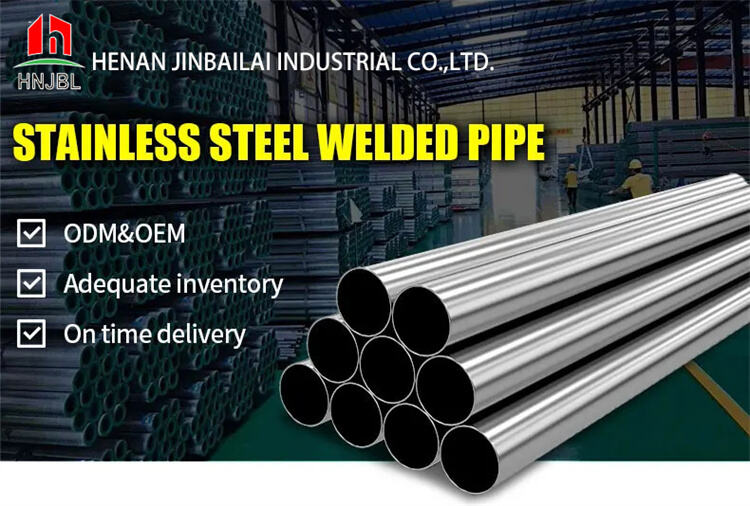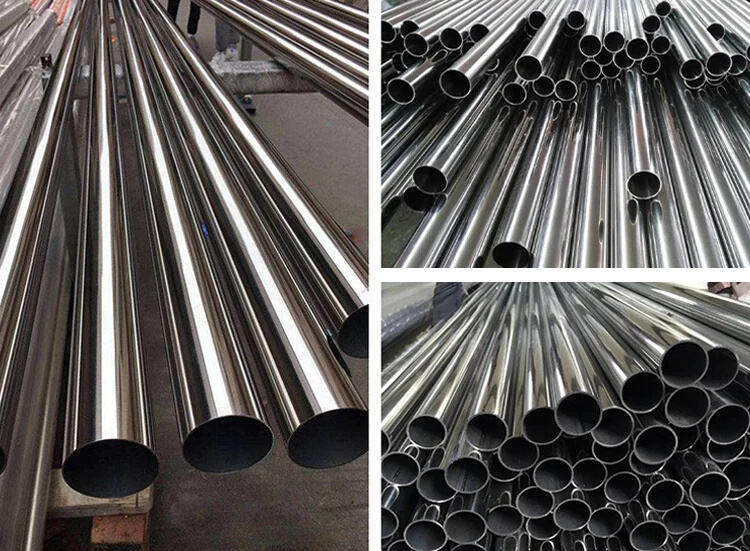Stainless steel welded pipes are widely used in various industries and construction fields due to their excellent corrosion resistance and strength. Welding technology is a key step in manufacturing stainless steel welded pipes. Choosing the right welding technology can not only improve the quality of welded pipes, but also optimize production efficiency.

What Is a Stainless Steel Welded Pipe?
Stainless steel welded pipes, referred to as welded pipes, are steel pipes made by welding steel or steel strips after curling and forming by units and dies. Welded steel pipes have simple production processes, high production efficiency, and many varieties and specifications, but their general strength is lower than that of seamless steel pipes.
What Are The Welding Technologies For Stainless Steel Welded Pipes?
The production process of stainless steel welded pipes usually includes forming, welding, cooling, straightening, surface treatment and other links. Welding is the most critical step, which determines the quality and performance of welded pipes. Common welding techniques include TIG welding, gas welding, submerged arc welding, manual arc welding and MIG/MAG welding.
1. TIG welding (argon arc welding):
TIG welding (Tungsten Inert Gas Welding) is the abbreviation of tungsten inert gas shielded arc welding, also known as argon arc welding (Argon Arc Welding). It is a welding technology that uses an arc and an inert gas (usually argon) to protect the welding area. This technology uses a tungsten electrode as a welding electrode, and argon is used to protect the arc and weld to prevent oxidation and contamination.
 Pros of TIG welding: high weld quality, small deformation, less pores, less cracks, good welding performance, and no spatter during the welding process.
Pros of TIG welding: high weld quality, small deformation, less pores, less cracks, good welding performance, and no spatter during the welding process.
 Cons of TIG welding: slow welding speed, high cost, difficult operation, high requirements for power supply stability, and not suitable for welding under high current.
Cons of TIG welding: slow welding speed, high cost, difficult operation, high requirements for power supply stability, and not suitable for welding under high current.
 Application: Argon arc welding is suitable for high-demand industrial applications such as aerospace, chemical equipment, and high-end architectural decoration. Due to its stable welding process and high quality, it is very suitable for the manufacture of precision stainless steel welded pipes.
Application: Argon arc welding is suitable for high-demand industrial applications such as aerospace, chemical equipment, and high-end architectural decoration. Due to its stable welding process and high quality, it is very suitable for the manufacture of precision stainless steel welded pipes.
2. Gas welding:
Gas welding is a welding technology that uses gas combustion to generate a high-temperature flame to melt stainless steel welded pipes. Commonly used fuel gases are acetylene and oxygen. The flame temperature is adjusted by controlling the gas ratio to achieve welding of materials. The combustible gases used for gas welding include acetylene, methane, liquefied petroleum gas, etc. Acetylene is currently the most commonly used in production. Because acetylene releases the most heat and has the highest flame temperature when burning in pure oxygen, which can reach 3150 degrees Celsius, it is usually called oxy-acetylene flame.
 Pros of gas welding: gas welding equipment has a simple structure, is easy to maintain, and has a low cost.
Pros of gas welding: gas welding equipment has a simple structure, is easy to maintain, and has a low cost.
 Cons of gas welding: The welding quality is unstable, gas welding has high control requirements for the welding process, and is easily affected by the operating environment and operating technology.
Cons of gas welding: The welding quality is unstable, gas welding has high control requirements for the welding process, and is easily affected by the operating environment and operating technology.
 Application: Gas welding is usually used for welding of low-thickness stainless steel pipes, and is suitable for relatively simple on-site repairs and small-scale welding tasks, such as household pipeline repairs and light structure welding.
Application: Gas welding is usually used for welding of low-thickness stainless steel pipes, and is suitable for relatively simple on-site repairs and small-scale welding tasks, such as household pipeline repairs and light structure welding.
3. Submerged Arc Welding:
Submerged Arc Welding (SAW) is a method of welding in which the arc is hidden under a flux layer. The flux forms a protective layer during the welding process to prevent oxidation and contamination. The arc generates heat through the flux layer and melts the welding area of the stainless steel welded pipe.
 Pros of submerged arc welding: Since the arc is hidden in the flux layer, the welding speed is fast, the weld is uniform, the welding process is stable, and the welding strength is high.
Pros of submerged arc welding: Since the arc is hidden in the flux layer, the welding speed is fast, the weld is uniform, the welding process is stable, and the welding strength is high.
 Cons of submerged arc welding: Special submerged arc welding equipment and flux are required, and the equipment investment is large; the welding process is relatively complicated and requires professional skills and experience.
Cons of submerged arc welding: Special submerged arc welding equipment and flux are required, and the equipment investment is large; the welding process is relatively complicated and requires professional skills and experience.
 Application: Submerged arc welding is widely used in large-scale industrial production, such as welding of oil pipelines, power equipment and large structural parts. Due to its high efficiency and excellent welding quality, it is suitable for occasions with long welds and high production requirements.
Application: Submerged arc welding is widely used in large-scale industrial production, such as welding of oil pipelines, power equipment and large structural parts. Due to its high efficiency and excellent welding quality, it is suitable for occasions with long welds and high production requirements.
4. Manual arc welding (SMAW):
Manual arc welding (Shielded metal arc welding) is a method of welding through the heat generated by the arc and the electrode. The outer layer of the electrode is coated with a protective coating to prevent oxidation of the welding area. The electrode is continuously melted during the welding process to form a weld.
 Pros of manual arc welding: The manual welding equipment has a simple structure, is convenient for on-site operations, and has a relatively low cost; it can weld materials of various thicknesses and shapes and has strong adaptability.
Pros of manual arc welding: The manual welding equipment has a simple structure, is convenient for on-site operations, and has a relatively low cost; it can weld materials of various thicknesses and shapes and has strong adaptability.
 Cons of manual arc welding: The quality of the weld is greatly affected by the welder's skills and environmental conditions, and spatter and smoke during welding may also affect the quality of the weld; compared with automated welding methods, manual welding has lower production efficiency.
Cons of manual arc welding: The quality of the weld is greatly affected by the welder's skills and environmental conditions, and spatter and smoke during welding may also affect the quality of the weld; compared with automated welding methods, manual welding has lower production efficiency.
 Application: Manual arc welding is widely used in various on-site operations and maintenance work, especially for welding tasks with complex on-site conditions and special locations, such as construction and on-site equipment repair.
Application: Manual arc welding is widely used in various on-site operations and maintenance work, especially for welding tasks with complex on-site conditions and special locations, such as construction and on-site equipment repair.
5. MIG/MAG welding:
MIG (Metal Inert Gas) and MAG (Metal Active Gas) welding are methods of welding using an arc and a continuously supplied wire. MIG welding uses an inert gas (such as argon), while MAG welding uses an active gas (such as carbon dioxide). Both methods melt and fill the weld with a continuously supplied wire.
 Pros of MIG/MAG welding: fast welding speed, suitable for large-scale production and welding of long welds; uniform welds, few defects, stable welding process; high degree of automation, easy operation, and reduced manual intervention.
Pros of MIG/MAG welding: fast welding speed, suitable for large-scale production and welding of long welds; uniform welds, few defects, stable welding process; high degree of automation, easy operation, and reduced manual intervention.
 Cons of MIG/MAG welding: special equipment and gas supply system are required, and equipment investment is high; gas cost is high, which increases production cost.
Cons of MIG/MAG welding: special equipment and gas supply system are required, and equipment investment is high; gas cost is high, which increases production cost.
 Application: MIG/MAG welding is suitable for large-scale industrial production, such as automobile manufacturing, shipbuilding and construction engineering. Due to its efficient welding speed and excellent welding quality, it is widely used in various industrial welding needs.
Application: MIG/MAG welding is suitable for large-scale industrial production, such as automobile manufacturing, shipbuilding and construction engineering. Due to its efficient welding speed and excellent welding quality, it is widely used in various industrial welding needs.

There are many types of welding technologies for stainless steel welded pipes, and each technology has its unique advantages and limitations. Understanding the characteristics of various welding technologies and selecting appropriate methods according to actual production needs can effectively improve the quality and production efficiency of welded pipes.
Learn more about the product:
Email:info@steelgroups.com
Whatsapp:+86 17611015797
